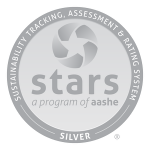“Auburn University is committed to integrating sustainability into all aspects of the University including: operations, instruction, research and outreach activities. Auburn University considers sustainability a core value and strives for excellence in sustainability through continuous assessment and improvement.”
— Auburn University Sustainability Policy Statement

First Earth Day demonstration in Philadelphia.
April 22, 1970 was the first Earth Day. It remains the largest demonstration in American history with 20 million people participating in rallies, teach-ins, and demonstrations across the country. It was an authentic citizens’ movement demanding action by government and business to address serious threats to the air, water, land, and living things. The environmental movement of the 1960s was interwoven with demands for change in societal, political, and economic conditions as well.
Here we are 46 years later recalling the first Earth Day, and reflecting on how far we have to go to achieve the goals of healthy people and a healthy planet so dramatically and passionately called for in the 1960s and 1970s.
By the end of the 1980s, the environmental movement broadened into the sustainability movement, taking a whole-systems view of conditions necessary for a thriving world: a healthy global ecosystem; a viable, just, and inclusive economy; vibrant, equitable, and inclusive societies, and conditions where individuals can experience fulfillment and wellbeing.
As four senior leaders from the international consulting firm Booz Allen Hamilton wrote in their 2008 book Megacommunities, we need to embrace new ways of doing things as called for in the sustainability movement because we live in “an interdependent world in crisis.”
With the sustainability movement gaining momentum throughout the 1990s, colleges and universities realized the relevance of sustainability to their institutional missions and the need to incorporate the principles, concepts, and practices of sustainability in their academic, operational, and outreach activities. Sustainability initiatives began appearing and rapidly grew across the landscape of higher education. Auburn University joined this sustainability movement in 2004.
Since then Auburn has, among other things, established an Office of Sustainability and Academic Sustainability Programs, become a signatory to the Climate Leadership Network’s Carbon Commitment which among other things sets a goal of achieving carbon neutrality by 2050 through energy efficiency measures and the ever-expanding use of renewable energy, incorporated sustainability into strategic plans, and perhaps most importantly, adopted a Sustainability Policy.
Sustainability in higher education grew so significantly that by 2005 a higher education sustainability association was created to foster progress and collaboration: AASHE, the Association for the Advancement of Sustainability in Higher Education, now with over 750 member institutions in 18 countries.
Colleges and universities began asking themselves what they should be measuring when it comes to sustainability, and how best to measure their efforts. They wondered what constitutes responsible performance, and how they compared to other colleges and universities. So in 2010, AASHE created STARS, the Sustainability Tracking Assessment & Rating System. In a very short time STARS has become THE sustainability performance system for higher education.
More than 700 institutions in 24 countries on 6 continents now use STARS to evaluate institutional performance in Academics, Engagement, Operations, and Planning & Administration. Institutions receive ratings reflecting one of four levels of performance: Bronze, Silver, Gold, or Platinum.

Auburn University received a Silver STARS rating for our latest assessment.
Auburn just completed our second STARS evaluation and received a STARS Silver rating in January 2016. Auburn’s STARS report contains a rich array of details and data on what we’ve accomplished to receive this recognition; we encourage you to take a look.
Any institution that subjects itself to the detailed self-analysis of a STARS report deserves credit for asking serious questions about important performance metrics. What we learned from our recent evaluation is that Auburn is on the right track. We are making progress.
But there is so much more to do. Looking ahead, we will keep moving forward, integrating the principles, practices, and concepts of sustainability at Auburn University on behalf of people, the planet, and all living things. Auburn will continue to use STARS to help us focus on what matters most in achieving this goal and we fully expect our STARS-guided efforts to lead us to achievements and impacts that will be reflected in higher STARS ratings in the future.
Everything we all do matters. By treating each other well, thoughtfully and conservatively using our resources, and taking care of the world around us in the conduct of our duties, we are doing our part helping Auburn University achieve its sustainability commitments and fulfill its mission of preparing its students and making the world a better place.




